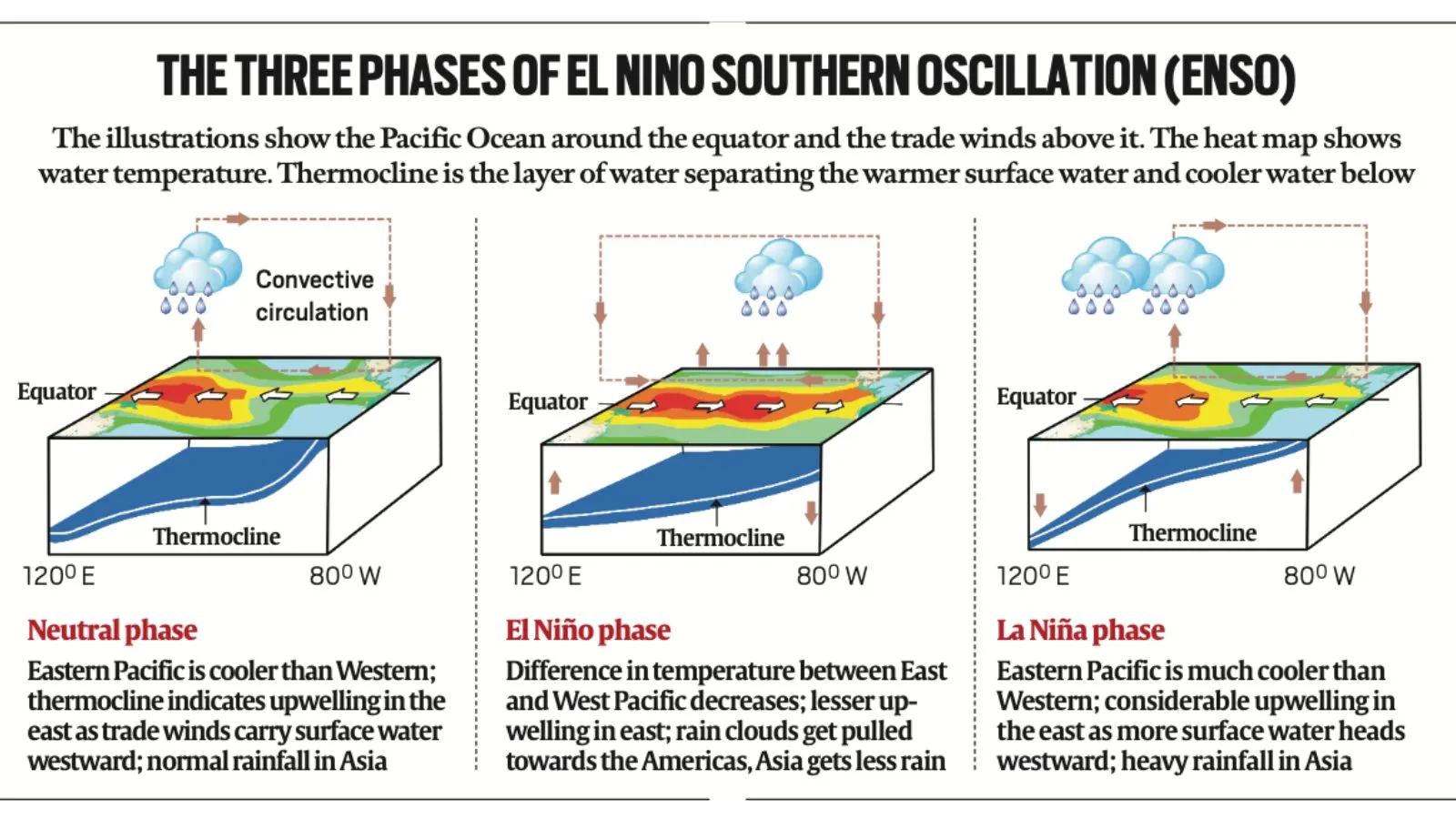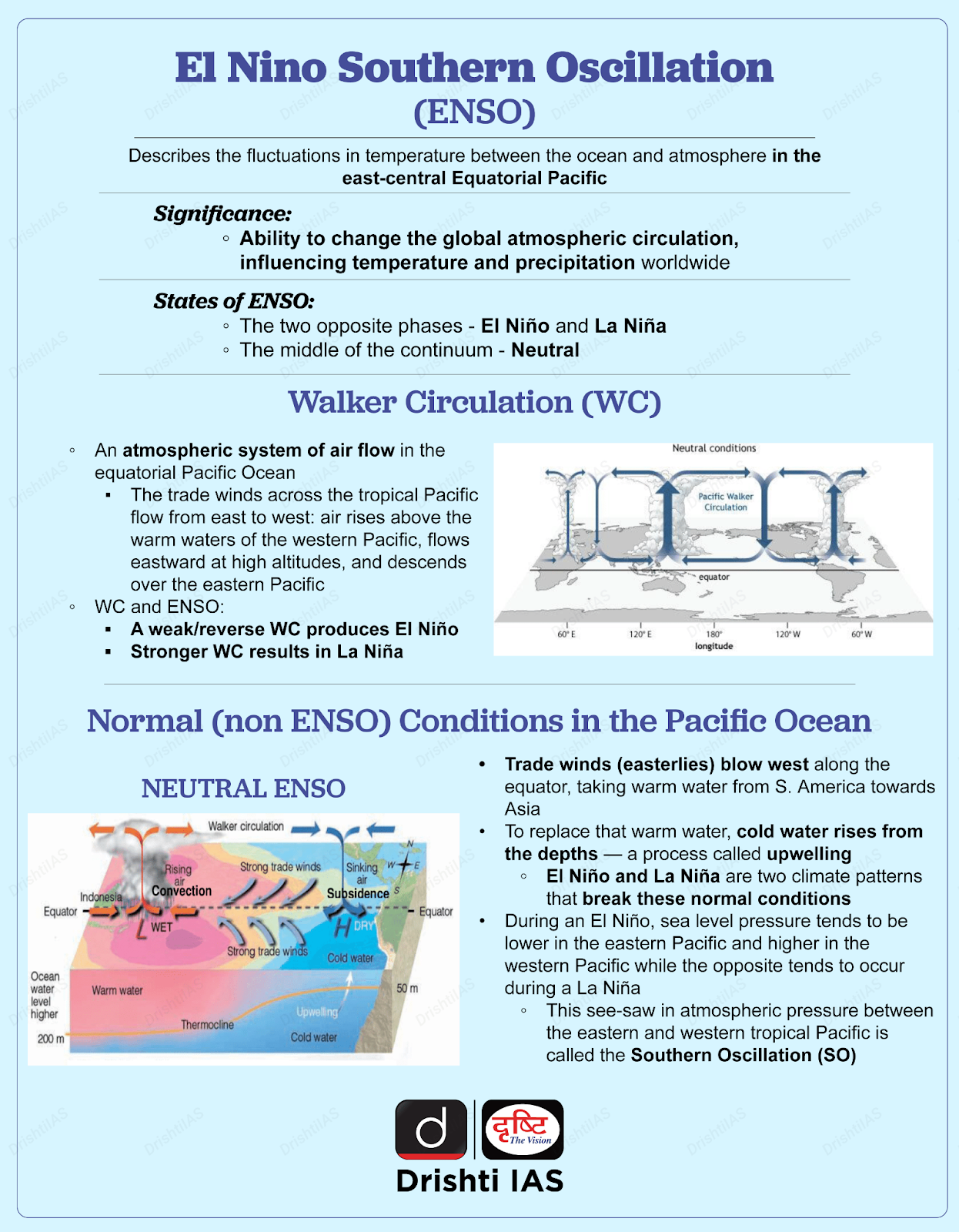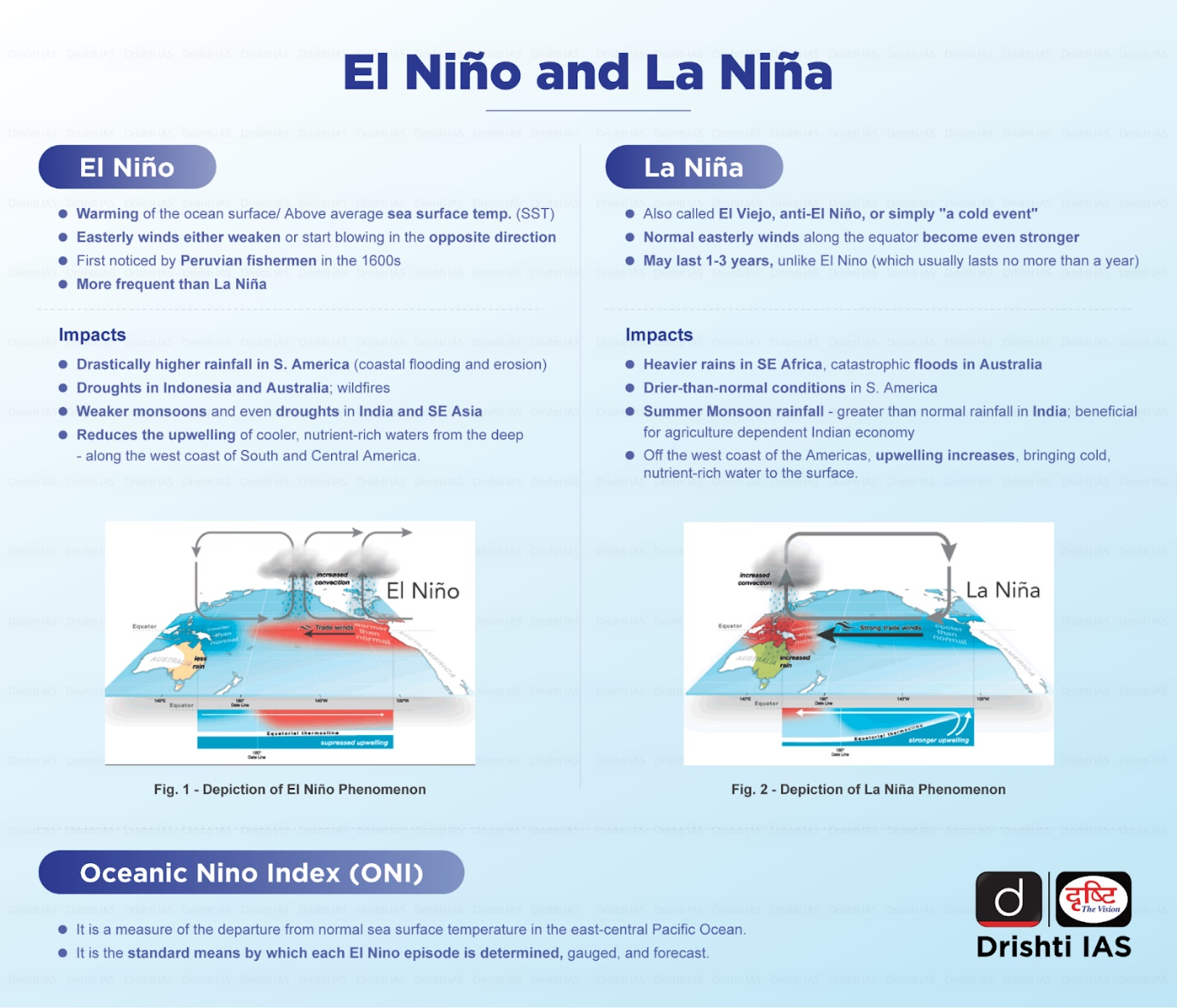Geography
La Niña Predictions
- 13 Sep 2024
- 10 min read
For Prelims: La Niña, El Niño Southern Oscillation (ENSO), the eastern Pacific, trade winds, climate change, National Oceanic and Atmospheric Administration (NOAA), Bureau of Meteorology (BoM), India Meteorological Department (IMD), Madden Julian Oscillation (MJO), the Arabian Sea, cyclone.
For Mains: Differentiate between El Niño and La Niña, its affect on Indian weather conditions.
Why in News?
Recently, all major global meteorological agencies have notably missed the mark in their predictions for La Niña in 2024.
- India had relied on this crucial climate phenomenon to bring increased rainfall during August-September 2024.
What is La Niña?
- La Niña, meaning "The Little Girl" in Spanish, is a phase of the El Niño Southern Oscillation (ENSO), a phenomenon that significantly drives global natural climate variability.
- ENSO is characterized by fluctuations in sea surface temperatures across the tropical Pacific Ocean, resulting from atmospheric variations above.
- These changes disrupt global atmospheric circulation and have widespread impacts on weather patterns across the world.
- The ENSO occurs in irregular cycles ranging from two to seven years and comprises three phases: warm (El Niño, or "The Little Boy" in Spanish), cool (La Niña), and neutral.
- During the neutral phase, the eastern Pacific (near the northwestern coast of South America) is cooler than the western Pacific (around the Philippines and Indonesia).
- This temperature difference arises due to prevailing trade winds, driven by Earth's rotation, which move from east to west between 30 degrees north and south of the equator, pushing warmer surface water westward.
- As a result, cooler waters from below rise to the surface to replace the displaced warm water.
- During the El Niño phase, trade winds weaken, resulting in less displacement of warm waters along the American coasts, causing the eastern Pacific to warm more than usual.
- In the La Niña phase, trade winds strengthen, pushing larger volumes of water toward the western Pacific, leading to cooler temperatures in the eastern Pacific.
- In India, El Niño is typically linked to reduced rainfall during the monsoon season, while La Niña tends to enhance monsoon activity.
- The most recent El Niño event occurred between June 2023 and May 2024, following one of the longest recorded La Niña episodes, which lasted from 2020 to 2023.
- In India, El Niño is typically linked to reduced rainfall during the monsoon season, while La Niña tends to enhance monsoon activity.
- The impacts of both El Niño and La Niña-related hazards, including extreme temperatures, heavy rainfall, and droughts, have been intensified by anthropogenic climate change.
What did Global Weather Models Predict in 2024?
- One of the strongest El Niño events on record concluded in June 2024, after which the ENSO entered a neutral phase.
- Initial forecasts from multiple global weather models predicted the onset of La Niña conditions around July. However, by mid-July, it became evident that La Niña would be delayed.
- The US-based NOAA indicated that the transition from neutral to positive sea surface temperatures, signaling the shift from ENSO neutral to La Niña, would likely occur between August and October.
- Similarly, the Bureau of Meteorology (BoM) in Australia maintained a La Niña ‘watch’ in July 2024, predicting the development of cooler-than-usual sea surface conditions in the latter half of the year.
- Since its initial Long Range Forecast issued in mid-April, the India Meteorological Department (IMD) consistently projected the emergence of La Niña.
- Crucially, La Niña was expected to enhance rainfall in August and September 2024, with seasonal prediction hinging on La Niña's development, which was anticipated to result in 'above normal' rainfall during the final two monsoon months.
Why were Initial Predictions off the Mark?
- The reason cited by weather meteorologists for the error in predicting La Niña’s onset is its expected mild intensity.
- Weather models tend to detect signals more accurately during strong La Niña (or El Niño) phases, but are less precise with weaker ones.
- Additionally, various factors influence surface and subsurface conditions across the Pacific Ocean, including inter-seasonal variability in atmospheric conditions, winds, and pressure.
- These are closely linked to the movement of the Madden Julian Oscillation (MJO), an eastward-moving band of rain-bearing winds and clouds.
- The interaction of these different weather systems complicates predictions.
- Recent forecasts suggest that the first signs of La Niña's onset will likely appear by late September or early October, with La Niña peaking in November and continuing throughout the winter in the northern hemisphere.
What will be the La Niña’s Impact on Indian Weather?
- La Niña is typically associated with enhanced rainfall during India's southwest monsoon.
- However, since 2024 monsoon season is nearly over and La Niña conditions have yet to develop in the equatorial Pacific Ocean, this climatic phenomenon will not directly influence the country's rainfall at present.
- If La Niña begins by late September or October, it may influence rainfall during the northeast monsoon season (October-December), which primarily affects Tamil Nadu, coastal Andhra Pradesh, Rayalaseema, southern interior Karnataka, and Kerala.
- Climatologically, La Niña is not favorable for northeast monsoon rainfall, although there have been exceptions in the past.
- The north Indian Ocean basin, including the Bay of Bengal and the Arabian Sea, typically experiences cyclone development during March to May and October to December, with peak activity in May and November.
- During La Niña years, there is a higher likelihood of frequent cyclogenesis, with storms potentially being more intense and longer-lasting.
- La Niña years have historically been associated with harsher and colder winters.
|
Drishti Mains Question: Discuss the phenomenon of La Niña and its impact on the Indian monsoon. How does it differ from El Niño in terms of its effects on India's climate? |
UPSC Civil Services Examination, Previous Year Question (PYQ)
Prelims
Q. La Nina is suspected to have caused recent floods in Australia. How is La Nina different from El Nino? (2011)
- La Nina is characterised by an usually cold ocean temperature in equatorial Indian Ocean whereas El Nino is characterised by unusually warm ocean temperature in the equatorial Pacific Ocean.
- El Nino has adverse effect on south-west monsoon of India but La Nina has no effect on monsoon climate.
Which of the statements given above is/are correct?
(a) 1 only
(b) 2 only
(c) Both 1 and 2
(d) Neither 1 nor 2
Ans: (d)
Mains
Q. Drought has been recognized as a disaster in view of its spatial expanse, temporal duration, slow onset and lasting effects on vulnerable sections. With a focus on the September 2010 guidelines from the National Disaster Management Authority (NDMA), discuss the mechanisms for preparedness to deal with likely El Nino and La Nina fallouts in India? (2014)









